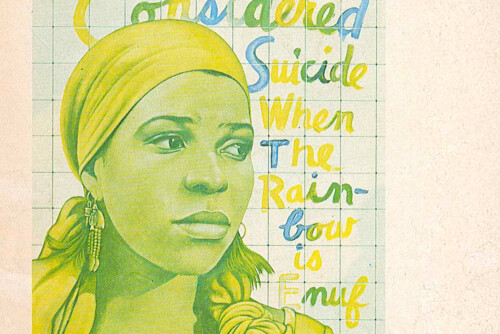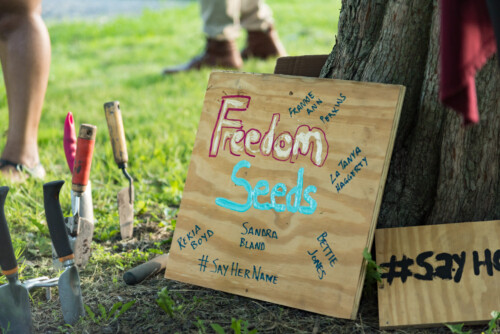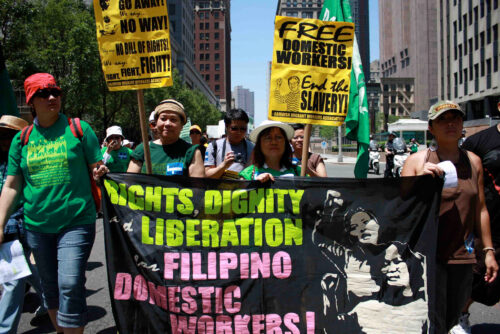Shange and Diaspora
Like most people of color, black people in the New World, I came by my passion for literature in a circuitous way, a night journey marked by music, movement, improvisation, and smells of perfume, sweat, and humid star-flickering nights.
—Ntozake Shange, “from analphabetic to script obsessed”1
We chose the title “The Worlds of Ntozake Shange” to highlight the singular ways her words perform and create worlds, a melding of form and afrodiasporic experience. The above epigraph captures the evolution of Shange’s work out of sensual experience, movement, people, place, and history. Our contributors chose a variety of terms—”consummate multimedia artist” (Brody); “dynamic, multidimensional” (Griffin); “poetic melding of body and voice”/ “choreopoetic” (Sullivan)—to capture Shange’s multimodal artistic and critical practice. This melding of dance, poetry, music, sight, and sound that Shange herself has called “carnal intellectuality” led to her singular achievement of the choreopoem.23 As Jennifer DeVere Brody and Mecca Jamilah Sullivan (in their respective essays in this volume) define it, the choreopoem is an “interdisciplinary performance where action, voice, and body all move collectively in a performative ‘inter(in)animation,’” a “form designed explicitly to represent the complexities of intersectional identity.” Theatrical and performative, two signal traits of black diasporic cultures, the choreopoem lives in the space between poetry, prose, and dialogue, between languages of the tongue and languages of the body. Nigerian poet/dramatist Niyi Osundare’s performance of his recent choreopoem, “A Hole in the Sky”—included in this volume—shares with Shange’s work a multilingual and multiply layered relationship to music, as well as a sense of necessary connection to the earth.
Her development of this embodied practice is intimately related to the ways Shange moves through her worlds as an artist and subject. Beginning in her childhood homes in St. Louis and New Jersey, where she and her siblings directly and indirectly experienced a range of black arts drawn from across the world (“when my parents traveled, which they did a lot, they brought the music and dance back with them”),4 and continuing throughout her life, Shange worked with artistic communities on both US coasts that were also communities of various identifications.5 Shange experienced the world physically, sensually, and politically, taking what she needed in the spirit of conservation and communion. Contributor Farah Jasmine Griffin argues that, with Jayne Cortez, Toni Cade Bambara, and other black writers, Shange introduced new black subjects to literature: “women . . . who were creative, multilingual, bohemian, literate, hip to avant-garde jazz and Latin music, and political.” Jennifer DeVere Brody proposes that Shange’s representation of these perhaps rarefied worlds is nonetheless linked to the celebration of the everyday in the tradition of Hurston and Alice Walker. The resolution of this tension between the rarefied and the quotidian is fictionalized in Sassafrass, Cypress and Indigo and chronicled in her cookbook/travelogue, if I can Cook, you Know God can as well as in lost in language and sound.
The evolution of for colored girls epitomizes the relationship of Shange’s artistic practice to place, space, and identity. While studying for her master’s degree, and, at the same time grappling with her desire to leave her academic program in order to join the musician Sun-Ra, Shange began performing her poetry, dancing, and studying in a range of communities. for colored girls metamorphosed from poetry to choreopoem during Shange’s movement between queer clubs, black women’s dance spaces, black music venues, multiracial feminist collectives, and women’s studies programs. In Shange’s words, “The space we used was the space I knew.”6 In the dance clubs, she developed “acceptance of the ethnicity of my thighs and backside,” which came with “a clearer understanding of my voice as a woman and a poet,” and in multilingual feminist spaces she continued to develop a black feminist consciousness that was always linked to the struggles of other women of color, a connection evoked in the flow of the line “Like most people of color, black people in the New World, I came by my passion for literature in a circuitous way.”7 It is helpful in this context to remember that the “rainbow” of for colored girls references the female Orishas,8 and that the earliest New York audiences of for colored girls, whose enthusiasm propelled it first to the Public Theater and then to Broadway, were Latina as well as black.9
Emerging as it does from these experiences of community and cross-pollination, it is no surprise that one of the gifts of for colored girls is that it establishes what Soyica Diggs Colbert calls “alternative socialities,” kinships which, because they are not built on family or blood ties, can create and sustain community as needed. One might say that performing for colored girls creates the possibilities for community that Shange has sustained and relied upon for her artistic development and survival. Thus we see throughout the volume that a variety of people and groups—US college students (Cobrin, Durden, Performing Shange video, Tobin-McCauley),10 queer artists (Sullivan),11 incarcerated women (Moller); Kenyan and Nigerian women (Kaigwa, Oguntokun) and others—have found in Shange’s words the space for healing and political critique. While people might originally connect through an experience of oppression, the healing comes through a collective experience of pleasure, sensuality, and the sacred; in other words, through what Audre Lorde calls “the erotic.”12
In her interview with director/writer Mũmbi Kaigwa, Chris Cynn notes that for colored girls, while profoundly black American in some respects, “also seems to be affirming a kind of Africanicity that’s rooted in the diaspora”; indeed, understanding Shange’s “pan-afro-hemispheric consciousness” is key to comprehending the nature and impact of her art.13 Vanessa K. Valdés’ examination of “Hispanic artistic motifs” in Shange’s work argues that “in regularly mentioning musical forms and artists from throughout the Americas, not only from the United States, Shange gives a more full representation of African diasporic life, suggesting an alternative, more ample definition of blackness.”14 Indeed, the Americas, particularly the Afro-Caribbean, is central to Shange’s sense of blackness: she locates her insistence on the African-ness of blackness not in romanticized visions of Africa, but in the crucible of slavery and the Middle Passage.
Shange’s connection to Africa is both pan-African and historically specific: she evokes a modern decolonizing Africa connected to global freedom struggles like the Latin American liberation movements, in which she participated. Farah Jasmine Griffin notes Shange’s and other black women’s marginalization from the Black Arts and Black Power movements; Shange recounts that her early insistence on the centrality of Caribbean-American experience was a key point of contention and that she found acceptance in Puerto Rican and Dominican venues absent from Black Power circles:8
When it came time for the black nationalists to talk about going to the Motherland, they all wanted to go to Africa. And I was concerned about the other black people who had been here 500 years, who had the same or similar experiences to me. And I wanted to know about them. Because that’s who I came from. And there were millions of us who had more in common than I had in common with the millions of people who had been left in Africa. No disrespect to them, but I came from a 500-year-old tradition that I felt I had to honor.15
Actress/playwright Robbie McCauley, who appeared on Broadway as the lady in red, tells Kate Tobin that this honoring of New World experience is at the heart of Shange’s language and poetics: “The story of American slavery—ripped away from one culture and having to go through the period of finding our feet in another place, and redefining ourselves, and still keeping the resonance of our original culture. Zake finds all of that in her language, in what’s resonated through her poems.”16 Shange’s characters (and indeed the pages of her work) develop connections across space to peoples scattered throughout the diaspora as well as a connection through time to the enslaved. Director Wole Oguntokun’s caution that there are “cities under the cities which Ntozake might not have been able to reach,” captures African experiences not touched by for colored girls, but ironically resonates with the key passage in Sassafrass, Cypress and Indigo where Indigo slips through time from “The Caverns” in Charleston to the slave dungeons of the Gold Coast.17
Carnal intellectuality is for Shange part of how we understand the knowledge and experience of ancestors in slavery. That experience is physical, even sensual (Valdés), and “attests to Shange’s deep and abiding interest in (black) embodied pleasure” (Brody). Dance, eating and music can link black people, particularly black women, not only to one another in healing and community (Colbert, Gumbs, Kaigwa, Sullivan) but also to modes of survival from the past:
this is one of my theories . . . that during slave times, when we were doing manual labor that was repetitive and hard, that that would create an endorphin high, the same way you get when you’re doing really intense physical energy—expending it. So your endorphins come out, and you can have visions or you can have a deep sense of concentration that allows you to keep going on and doing this physical thing that’s so hard, and, and creating sweat and perspiration, endorphins. And that mystical things can happen in that state. And that black women, as cleaners and helpers and cane cutters and cotton pickers and bean pickers and apple pickers and pineapple pickers and . . . all, every, all of that labor created a state, a state of mind that let, that left room for wondrous and beautiful thoughts to escape where we were.2
This sense that the everyday—and even the torturous—both connects black people to their past and leaves room “for wondrous and beautiful” thoughts and escape in the present is key to Shange’s impact (see also Stacey Muhammad). For instance, the child Indigo, an artist and healer, is a key example of Shange’s interest in innocence and black girlhood (also lady in brown, lady in yellow, Liliane, Betsey Brown).18 Her portrayal of Indigo gives readers “a pedagogy for the gifted child” (Griffin), but also materializes the connection between an ancestral past and bountiful future (“Indigo plays her own song and in so doing she also plays the songs of her ancestors while creating a pathway for the yet to be” [Brody]). Indigo’s immersion in the lives of “the folk” and transformation of quotidian experience is central to what Alexis Pauline Gumbs calls “Indigo subjectivity”: “in black feminist practice [Indigo subjectivity] is our materialization of a reality, an everyday portable and shareable lived experience that in its intent and physicality offers healing backwards and forwards in time and space.” Shange’s everyday, lived experience becomes a key part of her poetics (Brody). In a conversation with Paul Scolieri and Shange, choreographer Dianne McIntyre, a long-time Shange collaborator, laughingly remembers dancers trying to track down people and places named in Shange’s pieces only to find out that they were Shange’s neighbors, friends, and acquaintances, brought into the performance space with Celia Cruz, Archie Shepp, Tina Turner, Toussaint L’Overture, and other luminaries.19
- Shange, lost in language & sound 2011: 3 [↩]
- Ntozake Shange, “Ntozake Shange Conversation with ENGL3993,” The Worlds of Ntozake Shange Class Visit, II. United States, New York. 18 Apr. 2014. [↩] [↩]
- Shange discusses the development of for colored girls into a choreopoem in “a history: for colored girls who have considered suicide / when the rainbow is enuf” in lost in language & sound, pp. 6-12, and in the foreword, “Beginning, Middles and New Beginnings—A Mandala for Colored Girls: Musings and Meditations on the Occasion of the Second Publication,” to the 2010 edition of for colored girls (New York: Scribner, 2010). See also Neal Lester, “Introduction: The Choreopoem,” in Ntozake Shange: A Critical Study of the Plays (New York: Garland, 1995) 3-19. [↩]
- Shange, lost in language & sound 2011: xv. [↩]
- In “Subjects in History: Making Diasporic Identities,” Stuart Hall speaks of “a process of identifications, feeling yourself through the contingent, antagonistic and conflicting sentiments of which human beings are made up” rather than using a more static notion of identity. In The House That Race Built: Black Americans, U.S. Terrain, ed. Wahneema Lubiano (New York: Pantheon, 1997) 292. [↩]
- Shange, lost in language & sound 2011: 10. [↩]
- Shange, lost in language & sound 2011: 8. [↩]
- Ntozake Shange, “Ntozake Shange in Conversation with Thulani Davis,” The Worlds of Ntozake Shange Class Visit, 1 United States, New York. 17 Apr. 2014. [↩] [↩]
- Shange, lost in language & sound 2011: 11. [↩]
- Although not discussed in this issue, it worth noting that a Cambridge University performance of for colored girls directed by Justina Kehinde in 2012 was the first black, all-female performance at that university. [↩]
- See also Keith Boykin, ed., For Colored Boys Who Have Considered Suicide When the Rainbow Is Still Not Enough: Coming of Age, Coming Out, and Coming Home (Magnus Books, 2012). Megan Wacha, in assisting students with research for “The Worlds of Ntozake” class, suggested that the wealth of modern choreopoems coming from black gay men (particularly in the Midwest) who post their work on Twitter and Instagram could be a fruitful avenue for future research. [↩]
- Audre Lorde, “Uses of the Erotic: The Erotic as Power,” Sister Outsider: Essays and Speeches by Audre Lorde (Freedom: Crossing, 1984) 53-59. [↩]
- Shange, lost in language & sound 2011: 52. [↩]
- Vanessa K. Valdés “’there is no incongruence here’: Hispanic Notes in the Works of Ntozake Shange” CLA 53.2 (2009) 133, and reprinted in this issue here; see also Griffin, this issue. [↩]
- Ntozake Shange, “Ntozake Shange in Conversation with Thulani Davis,” The Worlds of Ntozake Shange Class Visit, 1 United States, New York. 17 Apr. 2014. See also If I Can Cook/ you Know God Can (Boston: Beacon Press, 1999) p.2 and throughout. [↩]
- McCauley and Tobin, this volume. [↩]
- Ntozake Shange, Sassafrass, Cypress and Indigo (Berkeley: Shameless Hussy, 1976) 49-50. [↩]
- See also Shange’s foreword to the volume Sugar in the Raw, in which she praises the teenaged subjects who are “able to cradle our vulnerabilities as they build on strengths needed to confront and enrich the next millennium.” Rebecca Carroll, Sugar in the Raw: Voices of Young Black Girls in America. (New York: Crown/Archetype, 2011) 11. [↩]
- See “A Conversation with Dianne McInytre and Ntozake Shange” in this issue. [↩]




